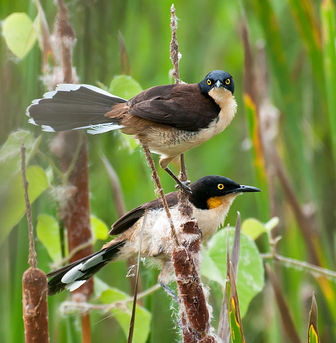Black-capped Donacobius
The Black-capped Donacobius is the only member of the genus Donacobius. Its familial placement is not established, and ornithologists disagree as to its closest relations. In the 19th century, it was placed in the Turdidae, and in the 20th century, moved to the Mimidae. It had various English names, including the Black-capped Mockingthrush. In the 1980s and 1990s, suggestions that it was a type of wren were accepted by the South American Classification Committee , the American Ornithologists Union and most other authorities. More recently, listing organizations and authors follow Van Remsen and Keith Barker's conclusion that it is not a wren either, but instead most closely related to an Old World lineage.

Original source: JAPACANIM (Donacobius atricapilla )Uploaded by Snowmanradio
Author: Dario Sanches from São Paulo, Brazil
The Black-capped Donacobius is classified as Least Concern. Does not qualify for a more at risk category. Widespread and abundant taxa are included in this category.
Physical characteristics: The black-capped donacobius wren averages in length from 8.5 to 9 inches (21 to 22 centimeters), with a weight of 1.1 to 1.5 ounces (31 to 42 grams). Its appearance makes the bird unique and unmistakable with a head and shoulders that are glossy black, a back that is more of a brown, and a rump that is olive-brown. Its tail feathers are black with noticeable white tips. Its wings are blackish with an obvious white flash at the bottom. More
that "the Black-capped Donacobius is a wren, not a mimid." Behavioral studies in Peru, where 18 groups of banded birds were followed for three years, supporting this transfer (Kiltie & Fitzpatrick 1984). Donacobius proved to be a cooperative breeder, with helpers at the nest in feeding young and territorial defense. This cooperative breeding behavior is more prevalent in wrens than in mimids; in addition, the vocal and display behaviors were unlike any mimid but rather like some Campylorhynchus wrens. More
The Black-capped Donacobius (Donacobius atricapilla) is a conspicuous, vocal South American bird. It is found in tropical swamps and wetlands in Argentina, Bolivia, Brazil, Colombia, Ecuador, French Guiana, Guyana, Paraguay, Peru, Suriname, and Venezuela; also Panama of Central America . More
Black-capped Donacobius determination Similar species Troglodytidae Black-capped Donacobius | Buff-breasted Wren | Coraya Wren | House Wren | Musician Wren | White-breasted Wood-Wren | Wing-banded Wren | Conservation status Black-capped Donacobius status Least Concern Black-capped Donacobius (Donacobius atricapilla) Passeriformes | Troglodytidae | Donacobius atricapilla | Black-capped Donacobius | Troglodyte More
Black-capped Donacobius on BirdForum TV Retrieved from "http://www.birdforum.net/opus/Black-capped_Donacobius" Categories: Birds | Donacobius | Videos Advertisement * This page was last modified 09:26, 8 March 2010. * This page has been accessed 1,812 times. * Privacy policy * About Opus * Disclaimers Search the net with ask. More
For the purposes of our bird news services, Black-capped Donacobius is classed as Ungraded: species which are unlikely to appear as wild birds in Britain or Ireland hide section Most recent photos of Black-capped Donacobius (3) Pantanal, Brazil Pantanal, Brazil01/09/2008 Pantanal, Brazil 01/09/2008 Santa Teresa, Mato Grosso, Brazil Santa Teresa, Mato Grosso, Brazil20/10/2008 Santa Teresa, Mato Grosso, Brazil 20/10/2008 Parque Estadual de Itaúnas, Espírito Santo, Brazil Parque Estadual de Itaúnas, Espírito More
Formerly of uncertain taxonomy the Black-capped Donacobius has now been adjudged to form a family of its own, the Donacobiidae. In the 19th century, it was placed in the Turdidae, and in the 20th century, moved to the Mimidae. It had various English names, including the "Black-capped Mockingthrush". In the 1980s and 1990s, suggestions that it was a type of wren (Troglodytidae) were accepted by the South American Classification Committee (SACC), the American Ornithologists Union (AOU) and most other authorities. More
Black-capped Donacobius are common in a wide range of Amazonian wetlands, including oxbow lakes, riparian zones, and other areas with tall dense aquatic or semi-aquatic vegetation. A third of the species range is outside the Amazon Basin, from Panama, northern Colombia, and western Venezuela, the Orinoco River system of Venezuela, to southeast coastal and inland Brazil, and neighboring countries southward, Paraguay, and extreme northern Argentina. More
This is Black-capped Donacobius - Donacobius atricapilla captured in Manu area located in Amazon-rain-forest area of Peru. I was floating on the boat with my friend from England and our guide which was a bird expert. Our trip started early in the morning and we where on the one lake located few miles from wildlife center. We saw and photographed many interesting species during this morning. More

Original source: Caleb Slemmons
-Caleb Slemmons -Author: Caleb Slemmons
Permission: Some rights reserved
Family : Mimidae
Genus : Donacobius
Species : atricapilla
Authority : (Linnaeus, 1766)
